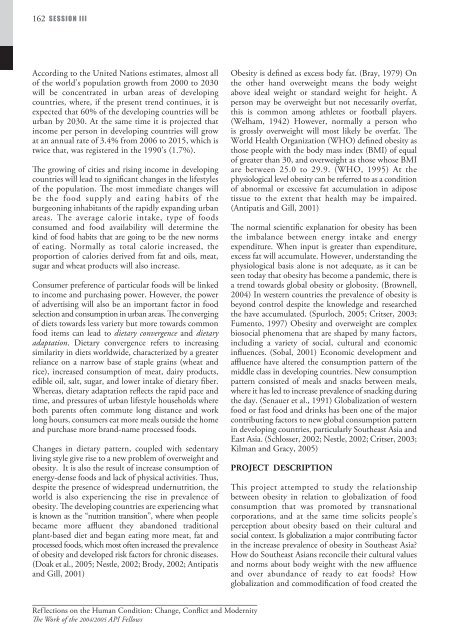Reflections on the Human Condition - Api-fellowships.org
Reflections on the Human Condition - Api-fellowships.org
Reflections on the Human Condition - Api-fellowships.org
You also want an ePaper? Increase the reach of your titles
YUMPU automatically turns print PDFs into web optimized ePapers that Google loves.
162 SESSION III<br />
According to <strong>the</strong> United Nati<strong>on</strong>s estimates, almost all<br />
of <strong>the</strong> world’s populati<strong>on</strong> growth from 2000 to 2030<br />
will be c<strong>on</strong>centrated in urban areas of developing<br />
countries, where, if <strong>the</strong> present trend c<strong>on</strong>tinues, it is<br />
expected that 60% of <strong>the</strong> developing countries will be<br />
urban by 2030. At <strong>the</strong> same time it is projected that<br />
income per pers<strong>on</strong> in developing countries will grow<br />
at an annual rate of 3.4% from 2006 to 2015, which is<br />
twice that, was registered in <strong>the</strong> 1990’s (1.7%).<br />
The growing of cities and rising income in developing<br />
countries will lead to significant changes in <strong>the</strong> lifestyles<br />
of <strong>the</strong> populati<strong>on</strong>. The most immediate changes will<br />
be <strong>the</strong> food supply and eating habits of <strong>the</strong><br />
burge<strong>on</strong>ing inhabitants of <strong>the</strong> rapidly expanding urban<br />
areas. The average calorie intake, type of foods<br />
c<strong>on</strong>sumed and food availability will determine <strong>the</strong><br />
kind of food habits that are going to be <strong>the</strong> new norms<br />
of eating. Normally as total calorie increased, <strong>the</strong><br />
proporti<strong>on</strong> of calories derived from fat and oils, meat,<br />
sugar and wheat products will also increase.<br />
C<strong>on</strong>sumer preference of particular foods will be linked<br />
to income and purchasing power. However, <strong>the</strong> power<br />
of advertising will also be an important factor in food<br />
selecti<strong>on</strong> and c<strong>on</strong>sumpti<strong>on</strong> in urban areas. The c<strong>on</strong>verging<br />
of diets towards less variety but more towards comm<strong>on</strong><br />
food items can lead to dietary c<strong>on</strong>vergence and dietary<br />
adaptati<strong>on</strong>. Dietary c<strong>on</strong>vergence refers to increasing<br />
similarity in diets worldwide, characterized by a greater<br />
reliance <strong>on</strong> a narrow base of staple grains (wheat and<br />
rice), increased c<strong>on</strong>sumpti<strong>on</strong> of meat, dairy products,<br />
edible oil, salt, sugar, and lower intake of dietary fiber.<br />
Whereas, dietary adaptati<strong>on</strong> reflects <strong>the</strong> rapid pace and<br />
time, and pressures of urban lifestyle households where<br />
both parents often commute l<strong>on</strong>g distance and work<br />
l<strong>on</strong>g hours, c<strong>on</strong>sumers eat more meals outside <strong>the</strong> home<br />
and purchase more brand-name processed foods.<br />
Changes in dietary pattern, coupled with sedentary<br />
living style give rise to a new problem of overweight and<br />
obesity. It is also <strong>the</strong> result of increase c<strong>on</strong>sumpti<strong>on</strong> of<br />
energy-dense foods and lack of physical activities. Thus,<br />
despite <strong>the</strong> presence of widespread undernutriti<strong>on</strong>, <strong>the</strong><br />
world is also experiencing <strong>the</strong> rise in prevalence of<br />
obesity. The developing countries are experiencing what<br />
is known as <strong>the</strong> “nutriti<strong>on</strong> transiti<strong>on</strong>”, where when people<br />
became more affluent <strong>the</strong>y aband<strong>on</strong>ed traditi<strong>on</strong>al<br />
plant-based diet and began eating more meat, fat and<br />
processed foods, which most often increased <strong>the</strong> prevalence<br />
of obesity and developed risk factors for chr<strong>on</strong>ic diseases.<br />
(Doak et al., 2005; Nestle, 2002; Brody, 2002; Antipatis<br />
and Gill, 2001)<br />
Ref lecti<strong>on</strong>s <strong>on</strong> <strong>the</strong> <strong>Human</strong> C<strong>on</strong>diti<strong>on</strong>: Change, C<strong>on</strong>flict and Modernity<br />
The Work of <strong>the</strong> 2004/2005 API Fellows<br />
Obesity is defined as excess body fat. (Bray, 1979) On<br />
<strong>the</strong> o<strong>the</strong>r hand overweight means <strong>the</strong> body weight<br />
above ideal weight or standard weight for height. A<br />
pers<strong>on</strong> may be overweight but not necessarily overfat,<br />
this is comm<strong>on</strong> am<strong>on</strong>g athletes or football players.<br />
(Welham, 1942) However, normally a pers<strong>on</strong> who<br />
is grossly overweight will most likely be overfat. The<br />
World Health Organizati<strong>on</strong> (WHO) defined obesity as<br />
those people with <strong>the</strong> body mass index (BMI) of equal<br />
of greater than 30, and overweight as those whose BMI<br />
are between 25.0 to 29.9. (WHO, 1995) At <strong>the</strong><br />
physiological level obesity can be referred to as a c<strong>on</strong>diti<strong>on</strong><br />
of abnormal or excessive fat accumulati<strong>on</strong> in adipose<br />
tissue to <strong>the</strong> extent that health may be impaired.<br />
(Antipatis and Gill, 2001)<br />
The normal scientific explanati<strong>on</strong> for obesity has been<br />
<strong>the</strong> imbalance between energy intake and energy<br />
expenditure. When input is greater than expenditure,<br />
excess fat will accumulate. However, understanding <strong>the</strong><br />
physiological basis al<strong>on</strong>e is not adequate, as it can be<br />
seen today that obesity has become a pandemic, <strong>the</strong>re is<br />
a trend towards global obesity or globosity. (Brownell,<br />
2004) In western countries <strong>the</strong> prevalence of obesity is<br />
bey<strong>on</strong>d c<strong>on</strong>trol despite <strong>the</strong> knowledge and researched<br />
<strong>the</strong> have accumulated. (Spurloch, 2005; Critser, 2003;<br />
Fumento, 1997) Obesity and overweight are complex<br />
biosocial phenomena that are shaped by many factors,<br />
including a variety of social, cultural and ec<strong>on</strong>omic<br />
influences. (Sobal, 2001) Ec<strong>on</strong>omic development and<br />
affluence have altered <strong>the</strong> c<strong>on</strong>sumpti<strong>on</strong> pattern of <strong>the</strong><br />
middle class in developing countries. New c<strong>on</strong>sumpti<strong>on</strong><br />
pattern c<strong>on</strong>sisted of meals and snacks between meals,<br />
where it has led to increase prevalence of snacking during<br />
<strong>the</strong> day. (Senauer et al., 1991) Globalizati<strong>on</strong> of western<br />
food or fast food and drinks has been <strong>on</strong>e of <strong>the</strong> major<br />
c<strong>on</strong>tributing factors to new global c<strong>on</strong>sumpti<strong>on</strong> pattern<br />
in developing countries, particularly Sou<strong>the</strong>ast Asia and<br />
East Asia. (Schlosser, 2002; Nestle, 2002; Critser, 2003;<br />
Kilman and Gracy, 2005)<br />
PROJECT DESCRIPTION<br />
This project attempted to study <strong>the</strong> relati<strong>on</strong>ship<br />
between obesity in relati<strong>on</strong> to globalizati<strong>on</strong> of food<br />
c<strong>on</strong>sumpti<strong>on</strong> that was promoted by transnati<strong>on</strong>al<br />
corporati<strong>on</strong>s, and at <strong>the</strong> same time solicits people’s<br />
percepti<strong>on</strong> about obesity based <strong>on</strong> <strong>the</strong>ir cultural and<br />
social c<strong>on</strong>text. Is globalizati<strong>on</strong> a major c<strong>on</strong>tributing factor<br />
in <strong>the</strong> increase prevalence of obesity in Sou<strong>the</strong>ast Asia?<br />
How do Sou<strong>the</strong>ast Asians rec<strong>on</strong>cile <strong>the</strong>ir cultural values<br />
and norms about body weight with <strong>the</strong> new affluence<br />
and over abundance of ready to eat foods? How<br />
globalizati<strong>on</strong> and commodificati<strong>on</strong> of food created <strong>the</strong>

















